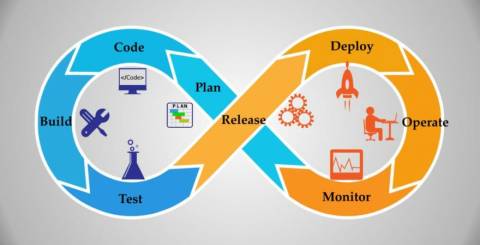Issue Tracking System in DevOps

DevOps and Agile approach in an organization is not merely an implementation of certain tools and techniques, instead, it is cultural change. Many organizations in the software industry have either adopted these methodologies or are making accommodations to incorporate them in their system. As opposed to the traditional waterfall management approach, DevOps and agility in projects mean continuous integration and continuous delivery, and shortened release cycles. This means that project managers and teams can no longer identify and resolve issues in the system on an ad hoc basis as it is not a viable option in the fast-paced business environment.
So, how do companies then track and manage defects and issues in their code? What measures can be taken by them to ensure that customer-generated tickets and reported bugs are addressed by the right team members in a timely manner to facilitate high-quality software deployments? And, lastly, how can companies ascertain that these bugs and defects are handled properly while introducing new features and aspects in the system concurrently? The answer to all of these questions is; a proficient and well-implemented issue tracking tool.
The underlying aim of issue tracking solutions that are embedded in the systems is to capture issues while they are still in the early stages, prioritize them according to their severity and impact on the project, assign them to the right team members, and lastly, track their progress. As a result, the project managers are able to handle all issues and defects that prop up in a way that aligns well with agile and DevOps practices.
The Unique Approach of DevOps Teams
The predominant differentiating factor for the DevOps teams is the extensive application of the continuous delivery approach. They tend to check-in code and build models frequently. Based on this approach, DevOps teams are generally making smaller changes in the system more frequently as opposed to larger changes less frequently. This denotes that these teams are also continuously testing and logging in the reported issues in the system by using automated tests to assess every change in the code and gauge if those changes pass the test of being defect-free. By religiously using the continuous delivery approach and treating the system infrastructure as code, the DevOps teams ensure that anytime a change is made in the environment, it is updated throughout the delivery system. Owing to the continuous assessment of the delivery processes and the software application, the developers and testing teams are able to glean rich and meaningful feedback and thus insights. The primary benefit of this continuous feedback system is to make small, incremental changes in the application system so that the organization is able to deliver on their business values while enhancing their delivering speed, time, and most importantly, quality. The role of issue tracking tools in this ecosystem is vital to not only support the continuous delivery and assessment system but to also provide better visibility and traceability for managers by bringing information from multiple sources into one centralized platform.
Important Features of Issue Tracking System
Given that testing is a crucial aspect of the developmental life cycle, it is important to set effective parameters to achieve all the specified requirements of the project. With an issue tracking system embedded in the application development system, the management of teamwork becomes easier through increased collaboration and the reporting gaps throughout the entire process is shortened. Issue tracking and management, when implemented adequately, also bring unparalleled flexibility and transparency in the entire development and the quality assurance process.
The reduction in the cost of development of the project can be achieved by the issue tracking system, and it also enables the project managers to come up with effective solutions for various agile projects. As this tool is armed with the features and techniques to not only deal but effectively manage different complexity levels, it enables the project teams to ultimately reduce the occurrence of bugs in the system, improve the project delivery, and in turn the client satisfaction as well. The backlog of the issues becomes extensive and unfathomable if they are left unchecked and not tracked with these tools. If a critical issue that requires a substantial amount of resources and efforts is dealt with without the help of an issue tracking system, it can become very time-consuming and tiresome. With this tool, as soon as the issues and defects are reported, the relevant team members are assigned to them automatically while the project managers can track the progress of the whole activity with a few clicks.
Similar Articles
For modern businesses to thrive, ensuring the effective management of inventory stands has become vitally important. Inventory management stands as a cornerstone of success. And the emergence of the Internet of Things (IoT) has introduced a new era of connectivity and efficiency across diverse industries.
Do you know what the following e-commerce companies have in common: Amazon, Walmart, eBay, and more? All of these e-commerce companies' apps make use of Java. Java is decidedly among the leading choices of programming language for e-commerce applications because it offers a world of benefits; for example, since Java code can be run on any platform with a Java Virtual Machine (JVM), users of e-commerce apps made with Java can access the said apps on a variety of devices.
Nikola Tesla in 1926, once described what is now called a mobile phone as a telephone that can fit into one's “vest pocket.” As otherworldly as that idea was then, nearly a century later, the reality is even more astounding.
Given the staggeringly high amounts of data being generated worldwide every single day, it ought to come as no surprise that organizations often struggle to pick the right tools to help them effectively harness the potential of all their data.
Managing properties can be a difficult task with the right tools. Property owners must find and use the best property management software. It can be a long and tedious process as there are many options in the property management software market.
In the ever-evolving financial services landscape, industry challenges are numerous and complex. From stringent regulations to rapidly advancing technology and changing consumer expectations, financial institutions face many obstacles.
The human learning capability is a great resource for helping technology evolve and grow, breaking boundaries, and creating new ones. Emulating the ability of humans to learn at a gradual but retentive pace, Machine Learning is the latest power monster that is redefining human-machine interaction.
In the ever-evolving landscape of low-code development, Microsoft's Power Platform stands out as a powerful tool for building custom applications. In today's dynamic digital landscape, creating and managing web pages is no longer the exclusive realm of professional web developers
In the data-driven business world, where information is of utmost priority, organizations are increasingly turning to data warehousing and data marts to harness the power of their data. These data management solutions are pivotal in transforming raw data into actionable insights.









